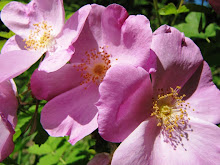There are few places that are more fun to hang out around than ponds. Whether the pond is large or small, it is an attraction for all kinds of critters. Frogs, snakes (hate those), birds, and mammals of all kinds gravitate toward ponds for drinking or, in the case of frogs and numerous insects, ponds provide a place to breed and raise a family. You may click on the pictures to see them in a larger format if you wish.
In the picture above is a tadpole, sometimes called a "pollywog" and in reality a frog in the making. Over time the tadpole will develop lungs, grow legs, lose its tail, and become a full-fledged frog. The pictures in this entry were all (with the exception of the wood frog) taken at or by my very small fishpond, which shows that you don't need to have access to a large pond in order to see lots of critters.
.
What kind of frog will the tadpole grow into? Will it be a leopard frog like the one pictured above, sunning itself on the rocks? Or maybe it will become a little grey treefrog like the one pictured below. The frog is green, but it is truly a gray treefrog and can change its color to match its surroundings. If the tadpole escapes being eaten by water beetles, birds, snakes, or another larger frog, it will become some kind of frog.
Pictured above is another kind of frog that tadpole could become: a wood frog. This one had already grown enough to leave the pond and hop about at will in search of food. But he will return to the pond at times, drawn by the water and the safety a pond offers.
The leopard frog above has found a fine hiding place amongst the water lilies in the pond. He can peek out to see his world, but can also zip under the lily leaves to escape danger. Frogs are fabulous swimmers and can move very quickly. Just try to catch one sometime and you will see how fast they can move!
The huge leopard frog (above) has found himself a fine place to hide and catch insects with his sticky tongue. If danger threatens he can retreat under the rocks, but while it is safe he suns himself and occasionally snacks on an unwary insect. He must be feeding well judging from the fat he is carrying, and I suspect that he has filled himself a time or two on tadpoles.
Above is a wood frog taking a rest on a mossy stone. Wood frogs are usually seen in the woods (surprise!) where they can blend into the leaf duff and hide amongst the leaves and plants that grow on the forest floor. Below is a small gray tree frog that has left the pond it was born into and crossed the yard to take a seat on a daisy. Tree frogs can change colors to a point, but they cannot become as yellow as the daisy! Still, this frog may be mistaken for a piece of stem or leaf by an insect coming to the flower. One zip of the frog's sticky tongue, and the insect becomes a froggy's dinner.
Frogs are fun to watch as they develop from a tadpole to a frog. Sometime if you have access to a pond, even a small one, take time to see what lives in it and what comes to it. A pond has a world all its own and it is a fascinating world to explore. Enjoy!







































